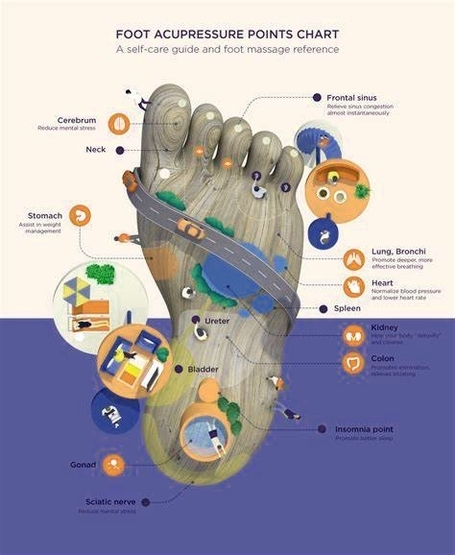Foot Acupressure Points
Foot acupressure, also known as foot reflexology, is a centuries-old practice that involves applying pressure to different points on the bottom of the foot. These points correspond to different areas of the body and are believed to have multiple benefits, including reducing stress, aiding digestion, and promoting sound sleep.
Concept and History
Reflexology is a holistic practice performed on the feet. The concept is that there are meridian points on the feet that correspond with various organs in the body. Reflexology is ancient medicine its been around forever. It can be traced as far back as 2330 B.C. According to traditional Chinese medicine (TCM), certain body parts are thought to be linked through pressure points, and reflexology offers relief by manipulating these pressure points in areas of the body that are difficult to access and treat.
Foot Pressure Points and Corresponding Body Regions
There are multiple pressure points in the feet, each believed to have a corresponding area in the body that may benefit from distant pressure or massage. Here are some of the key foot pressure points and their corresponding body regions:
– Tips of the toes: Head and brain
– Middle of the toes: Face and sinuses
– Base of the toes: Teeth, gums, and jaw
– Base of the pinky toe: Neck
– Outer side of the foot: Arms, elbows, knees, legs
– Inner side of the foot: Neck, brain stem, thymus, spine, and bladder
– Outer side of the ankle: Lower back
– Inner side of the ankle: Lymph glands, fallopian tubes, and groin
– Top, middle area of the foot: Lungs, chest, breast, and upper back
Benefits of Foot Reflexology
Foot reflexology may help with stress and relaxation, pain management, digestion, eyestrain, and improved sleep. One of the key benefits associated with reflexology is relaxation and stress management. This is achieved by applying pressure to certain points on the feet. Reflexology helps by increasing blood flow through the body, which helps to decrease stress and anxiety and lower blood pressure.
How to Practice Foot Reflexology
You can try reflexology on common areas of the foot that respond to pressure. Apply pressure with a thumb or finger and then rub with small, concentrated movements. Foot reflexology should not cause pain, so don’t push too hard. The pressure should feel similar to a foot massage.
Conclusion
Foot reflexology is a powerful practice with a rich history and a wide range of potential benefits. By understanding the key pressure points on the foot and how they correspond to different areas of the body, you can use this practice to promote relaxation, manage pain, and improve overall well-being..



